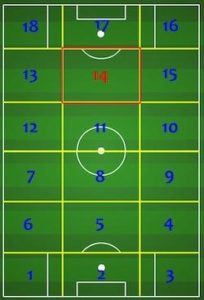Photo courtesy of Bethlehem Steel
Over the last three years the Philadelphia Union and Bethlehem Steel FC have displayed firm commitment to a single organization-wide identity, what Bethlehem head coach Brendan Burke has frequently called “the template.”
These are the major tactical characteristics of the template.
- Pacey, athletic, intelligent center backs who hold an aggressive, extremely high restraining line to compact space defensively against the opponent.
- “Volume players” in front of the defense who cover massive amounts of ground and can interchangeably assume situation-dictated offensive and defensive roles without regard to depth-chart position.
- Elite pace on the offensive flanks and at striker to both threaten space behind the defense and to do the dirty defensive running necessary to restrain and funnel the opposing attack.
- Poise, intelligence and technique in offensive “zone 5,” aka defensive “zone 14,” sufficient to both create opportunities and finish them. The zones are diagrammed below.

Image courtesy of American Soccer Now
The template has repeatedly been criticized as tactically inflexible.
An alternative
Emerging developments on the game pitch for Bethlehem suggest that within the basic parameters of the system, an alternative emphasis may perhaps provide significant tactical flexibility.
So, what’s new with the Steel? Not the defense, it remains as described above. But offensively, in circumstances determined by the lineup pickers who tell Coach Burke who’s playing, there has been a different balance among the template’s components of the attack.
Building off a highly respected local tactical analyst’s phrase “desire to own the ball in tight spaces,” the alternative balance emphasizes that desire above the combination of volume players and pace that threatens the open space behind a defense. Ilsinho illustrates “desire to own the ball in tight spaces” on the game pitches of the first team, as do Santi Moar and Adam Najem for Bethlehem.
Concrete evidence
Against Indy Eleven, on an extremely sticky artificial surface that necessitated one-touch combination passing instead of multiple individual touches, the Steel played an attacking combo that used one-touch combos extremely well. Aidan Apodaca at striker, Michee Ngalina at left wing, Fabian Herbers at right wing, Santi Moar at attacking center mid, and Adam Najem at center mid went through Indy’s central channel like a hot knife through butter, especially in the second half.
The Steel won the away match 2-1. Coach Burke rightly identified “defensive chops” as the group’s weakness, but on the day they won in a fashion new to fans of the Steel, small-sided one-touch through the center.
The key to the grouping is the combination of Moar and Najem in the middle. Both of them demand the ball at their feet in tight spaces. Moar smiles with pleasure when faced with the challenge; Najem’s face is more analytical as he breaks through.
Apodaca, Ngalina, (and Chris Nanco when he replaces Herbers), provide elite pace to complement the technical maestros. Herbers may be a quarter-count slower, but he has the skill to play with the group and is the most effective shooter.
He is also versatile. He is the better replacement for the currently injured Apodaca at striker, saving Nanco’s pace for the “tired-legs phase” of the opposing defenders’ games when possible, as happened recently against New York (see below).
Information for Union fans
The final point of interest from exploring this alternative tactical balance is the comparison of Anthony Fontana to Najem.
Najem is superior to Fontana in his technical control of the ball in tight spaces and his ability to create play within them. Najem’s possession in tight spaces is superior to Derrick Jones’s as he was in 2016, but not as Jones is now in 2018. His creativity remains better. Like Jones, Fontana may grow and develop over time.
Fontana is perceived superior to Najem as a volume player (although Najem was impressive when Chambers went off injured and the diminutive one dropped into the defensive center midfield slot against Nashville for the last 20 minutes). Ilsinho’s improvement as a volume player since his arrival to the first team, and the cliché that you cannot make a plow horse into an Arabian but you can make it into a faster one, suggest Najem may grow, too.
Each player works at least twice a week – the two-a-day practice days – on his individually tailored development plan remediating weaknesses. Each has an elite characteristic as demanded by the organization to continue playing for them, the characteristics are different.
Wrap up
At a practice after the Indy game, coach Burke’s presence at the monthly ownership meeting was deemed essential by Mr. Sugarman, so we spoke to assistant coach Steve Hogan about the performance against Indy Eleven. Hogan’s comment about the small, fast, skilled group that won the game was that he liked it also and hoped to see it again.
As the organization accumulates new assets over time, the template may include developing greater tactical flexibility within the 28-31 man first team roster. It certainly exists with the Steel. The recent starting combination of Ilsinho and Fafa Picault on the wings for the Union suggests it may come to with the first team.
P. S. News update

Mahoney scores from Nanco’s first assist
Chris Nanco made the USL team of the week for 2 assists in the game’s last six minutes in the draw against Red Bulls 2 at Goodman a week ago today. Nanco joins Santi Moar as the only Steel players to earn such league recognition more than once.


Good read, thank you.
Glad you enjoyed it.
Nicely done, Tim.